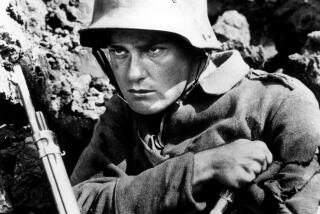A Uniform Security in ‘Last Laugh’
- Share via
The doorman, the unnamed hero-victim of F.W. Murnau’s “The Last Laugh,” loves his uniform. It’s a big, bulky symbol of power, and he feels renewed every time he wraps himself in it.
His neighbors respond with exaggerated respect. Whenever the doorman leaves the hotel where he works and strides home, they check him out, admiring the image. They like the strength his uniform projects; they feel more secure because of it.
Their reverence is close to surreal, and it says something about a culture that craves authority. Whether intentional or not, Murnau’s classic silent film predicts a Germany that would later give way to Hitler and his khaki-clad Nazi mob.
The 1924 movie, screening Friday as part of UC Irvine’s “Tragedy and Comedy” series, was made by the same man who created “Nosferatu,” a German Expressionism landmark that made the most of Bram Stoker’s “Dracula.” Like the 1922 horror flick, arguably the eeriest of the vampire movies, “The Last Laugh” is visually striking.
Murnau refused to use subtitles--he wanted famed cinematographer Karl Freund’s camera and the actors, especially Emil Jannings in the lead role, to tell the story.
Murnau, whose reputation rests primarily with those two films and “Sunrise” from 1927, was a director who was in tune with the silents. Coming out of the Expressionist movement (he started as an avant-garde stage director), Murnau emphasized the medium’s stark image potential, discovering that his moving pictures could have the same impact as, say, a painting by Edvard Munch.
The impact in “The Last Laugh,” which was written by Carl Mayer, one of Germany’s most lauded screenwriters, comes from Murnau’s direction and Freund’s inventive lens, but the story is full of meaning, like a warped fable. The tale of Jannings’ doorman is mundane but universal in its vanity and tragedy.
His fall comes when the hotel manager realizes the old man can’t handle heavy luggage any longer and is demoted to a restroom assistant. His uniform is taken away, but he steals it so he can wear it home, deceiving his neighbors and ensuring their respect.
Once discovered, the former doorman is ridiculed and begins a rapid descent. Humiliation leads to depression, which leads to booze. There’s more than a little melodrama in these scenes, but irony as well. The happy ending, which has been debated by film historians for years, is a wry coda that sardonically comments on the sentimentality that audiences of the day preferred.
Besides bringing Murnau, Freund and Mayer together, the picture is significant because of Jannings, considered the leading German actor of his era. Jannings, best known for starring opposite Marlene Dietrich in “The Blue Angel,” was as suited to the silents as Murnau; his dramatic gestures made the most of the period’s broadly suggestive quality.
A last note: The scheduling of “The Last Laugh” at UCI is timely, for Murnau died in a car accident the same day in 1931. He was 42.
What: F.W. Murnau’s “The Last Laugh.”
When: Friday, March 11, at 7 and 9 p.m.
Where: The UC Irvine Student Center’s Crystal Cove Auditorium.
Whereabouts: Take the San Diego (405) Freeway to Jamboree Road and head south to Campus Drive and take a left. Turn right on Bridge Road and take it into the campus.
Wherewithal: $2 to $4.
Where to call: (714) 856-6379.
More to Read
Only good movies
Get the Indie Focus newsletter, Mark Olsen's weekly guide to the world of cinema.
You may occasionally receive promotional content from the Los Angeles Times.










